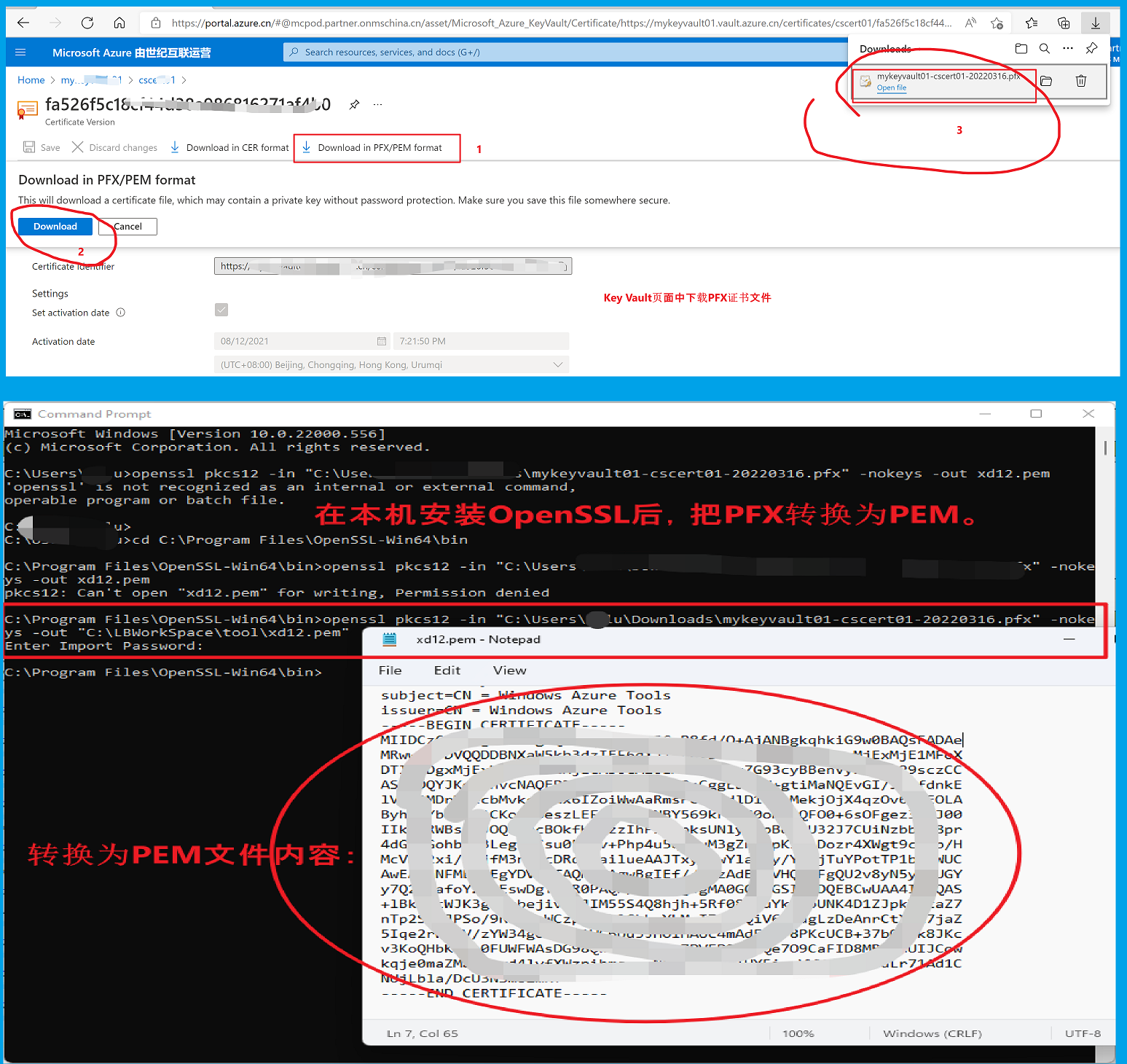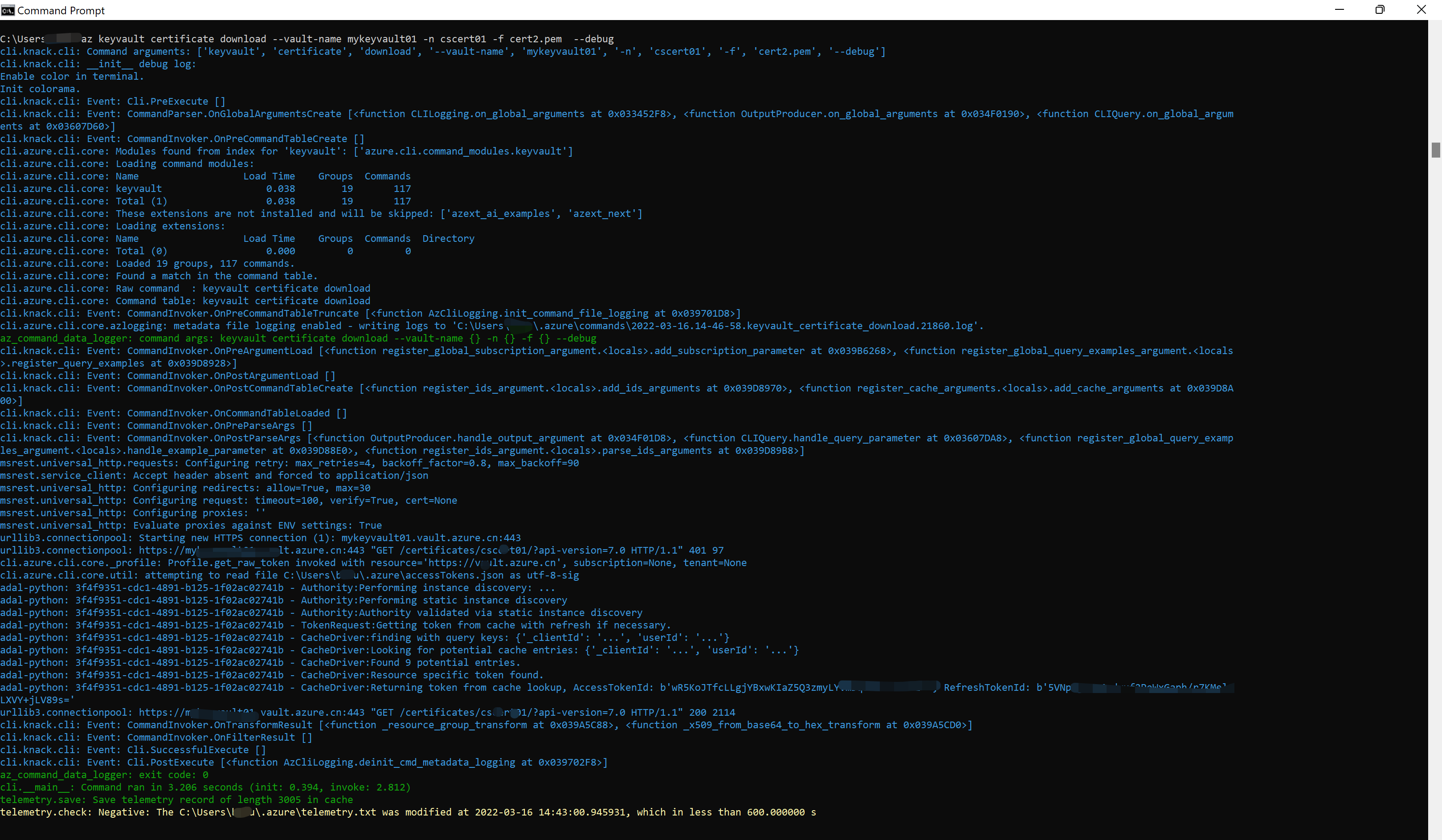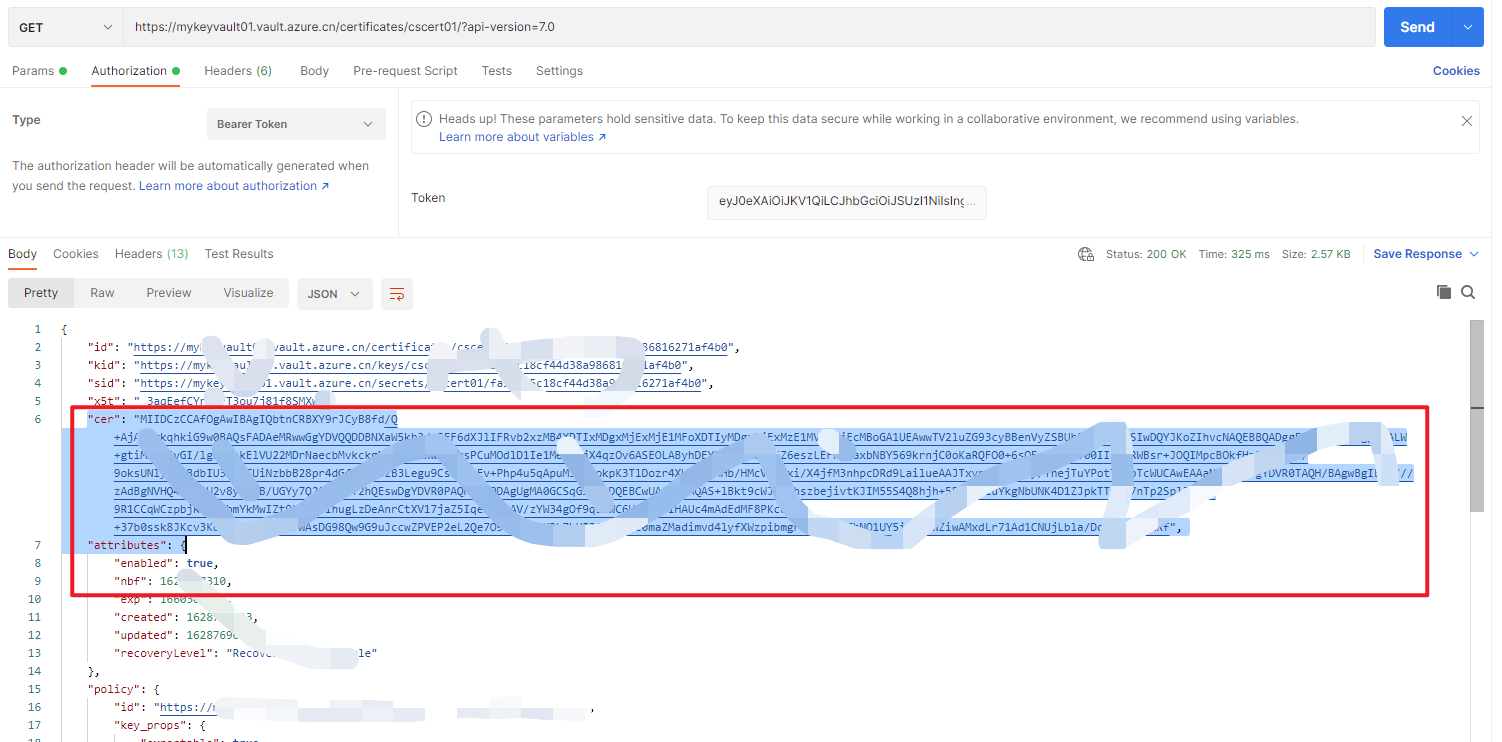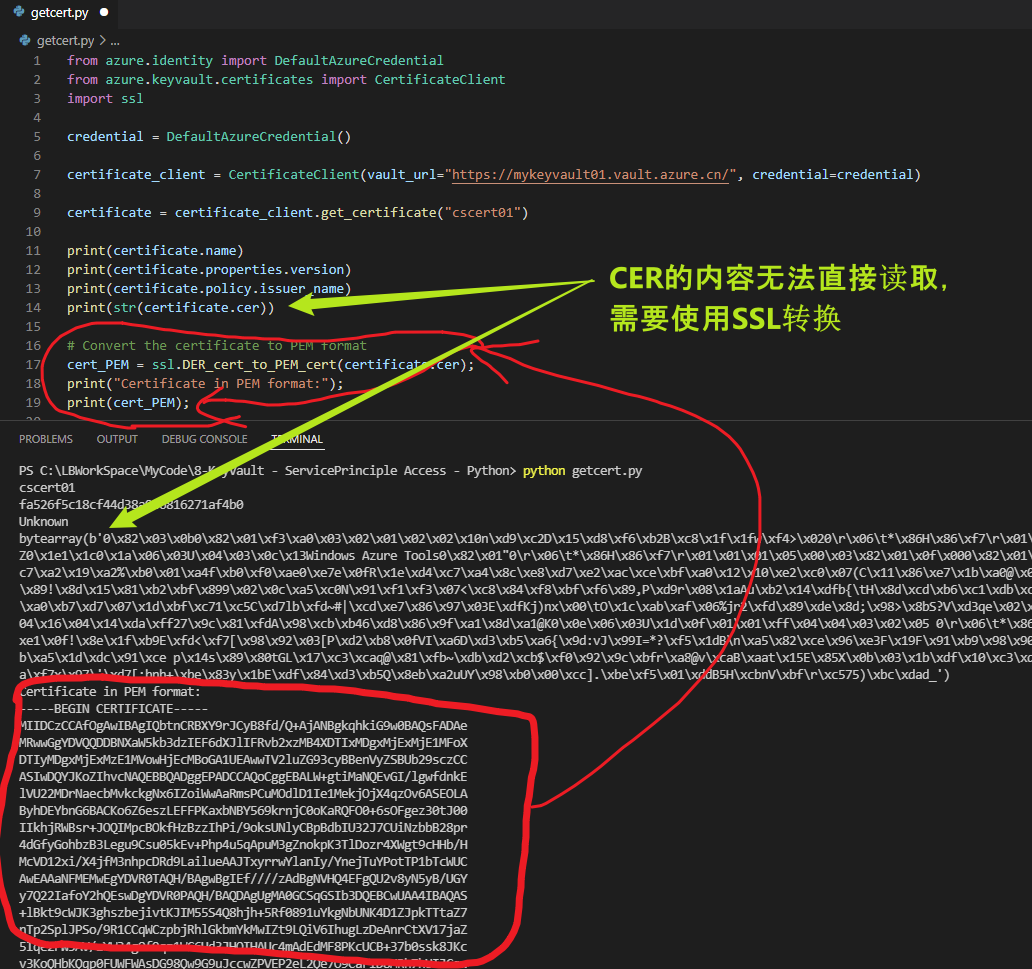在Azure Key Vault中,我们可以从Azure门户中下载证书PEM文件到本地。 可以通过OpenSSL把PFX文件转换到PEM文件。然后用TXT方式查看内容,操作步骤如下图:

OpenSSL转换命令为:
openssl pkcs12 -in "C:\Users\Downloads\mykeyvault01-cscert01-20220316.pfx" -nokeys -out "C:\tool\xd12.pem"
当然,Azure也提供了通过PowerShell或CLI命令来下载PEM文件,操作为:
az keyvault certificate download --vault-name vault -n cert-name -f cert.pem
(Source : https://docs.microsoft.com/en-us/cli/azure/keyvault/certificate?view=azure-cli-latest#az-keyvault-certificate-download)
那么,如何可以通过Python SDK的代码获取到PEM文件呢?
问题解答
查看 Python SDK Certificate中公布出来的接口,并没有 Export, Download 的方法。 Python Azure Key Vault SDK 中并没有可以直接下载PEM文件的方法。
Azure SDK For Python KeyVault -- CertificateClient Class : https://docs.microsoft.com/en-us/python/api/azure-keyvault-certificates/azure.keyvault.certificates.aio.certificateclient?view=azure-python#methods
Methods backup_certificateBack up a certificate in a protected form useable only by Azure Key Vault.
Requires certificates/backup permission. This is intended to allow copying a certificate from one vault to another. Both vaults must be owned by the same Azure subscription. Also, backup / restore cannot be performed across geopolitical boundaries. For example, a backup from a vault in a USA region cannot be restored to a vault in an EU region.
cancel_certificate_operationCancels an in-progress certificate operation. Requires the certificates/update permission.
create_certificateCreates a new certificate.
If this is the first version, the certificate resource is created. This operation requires the certificates/create permission. The poller requires the certificates/get permission, otherwise raises an HttpResponseError
create_issuerSets the specified certificate issuer. Requires certificates/setissuers permission.
delete_certificateDelete all versions of a certificate. Requires certificates/delete permission.
If the vault has soft-delete enabled, deletion may take several seconds to complete.
delete_certificate_operationDeletes and stops the creation operation for a specific certificate.
Requires the certificates/update permission.
delete_contactsDeletes the certificate contacts for the key vault. Requires the certificates/managecontacts permission.
delete_issuerDeletes the specified certificate issuer.
Requires certificates/manageissuers/deleteissuers permission.
get_certificateGets a certificate with its management policy attached. Requires certificates/get permission.
Does not accept the version of the certificate as a parameter. To get a specific version of the certificate, call get_certificate_version.
get_certificate_operationGets the creation operation of a certificate. Requires the certificates/get permission.
get_certificate_policyGets the policy for a certificate. Requires certificates/get permission.
Returns the specified certificate policy resources in the key vault.
get_certificate_versionGets a specific version of a certificate without returning its management policy.
Requires certificates/get permission. To get the latest version of the certificate, or to get the certificate's policy as well, call get_certificate.
get_contactsGets the certificate contacts for the key vault. Requires the certificates/managecontacts permission.
get_deleted_certificateGet a deleted certificate. Possible only in a vault with soft-delete enabled.
Requires certificates/get permission. Retrieves the deleted certificate information plus its attributes, such as retention interval, scheduled permanent deletion, and the current deletion recovery level.
get_issuerGets the specified certificate issuer. Requires certificates/manageissuers/getissuers permission.
import_certificateImport a certificate created externally. Requires certificates/import permission.
Imports an existing valid certificate, containing a private key, into Azure Key Vault. The certificate to be imported can be in either PFX or PEM format. If the certificate is in PEM format the PEM file must contain the key as well as x509 certificates, and you must provide a policy with content_type of pem.
Lists the currently-recoverable deleted certificates. Possible only if vault is soft-delete enabled.
Requires certificates/get/list permission. Retrieves the certificates in the current vault which are in a deleted state and ready for recovery or purging. This operation includes deletion-specific information.
list_properties_of_certificate_versionsList the identifiers and properties of a certificate's versions.
Requires certificates/list permission.
list_properties_of_certificatesList identifiers and properties of all certificates in the vault.
Requires certificates/list permission.
list_properties_of_issuersLists properties of the certificate issuers for the key vault.
Requires the certificates/manageissuers/getissuers permission.
merge_certificateMerges a certificate or a certificate chain with a key pair existing on the server.
Requires the certificates/create permission. Performs the merging of a certificate or certificate chain with a key pair currently available in the service. Make sure when creating the certificate to merge using create_certificate that you set its issuer to 'Unknown'. This way Key Vault knows that the certificate will not be signed by an issuer known to it.
purge_deleted_certificatePermanently deletes a deleted certificate. Possible only in vaults with soft-delete enabled.
Requires certificates/purge permission.
Performs an irreversible deletion of the specified certificate, without possibility for recovery. The operation is not available if the recovery_level does not specify 'Purgeable'. This method is only necessary for purging a certificate before its scheduled_purge_date.
recover_deleted_certificateRecover a deleted certificate to its latest version. Possible only in a vault with soft-delete enabled.
Requires certificates/recover permission. If the vault does not have soft-delete enabled, delete_certificate is permanent, and this method will raise an error. Attempting to recover a non-deleted certificate will also raise an error.
restore_certificate_backupRestore a certificate backup to the vault. Requires certificates/restore permission.
This restores all versions of the certificate, with its name, attributes, and access control policies. If the certificate's name is already in use, restoring it will fail. Also, the target vault must be owned by the same Microsoft Azure subscription as the source vault.
set_contactsSets the certificate contacts for the key vault. Requires certificates/managecontacts permission.
update_certificate_policyUpdates the policy for a certificate. Requires certificiates/update permission.
Set specified members in the certificate policy. Leaves others as null.
update_certificate_propertiesChange a certificate's properties. Requires certificates/update permission.
update_issuerUpdates the specified certificate issuer. Requires certificates/setissuers permission.
所以使用原始的SDK Methods方法不可行。
寻找解决方案
通过对CLI (az keyvault certificate download)指令的研究,发现CLI使用的是python代码执行的Get Certificates 操作,实质上是调用的Key Vault的REST API:
Get Certificate: https://docs.microsoft.com/en-us/rest/api/keyvault/certificates/get-certificate/get-certificate#getcertificate

DEBUG az 指令:
az keyvault certificate download --vault-name mykeyvault01 -n cscert01 -f cert2.pem --debug
C:\Users>az keyvault certificate download --vault-name mykeyvault01 -n cscert01 -f cert2.pem --debug cli.knack.cli: Command arguments: ['keyvault', 'certificate', 'download', '--vault-name', 'mykeyvault01', '-n', 'cscert01', '-f', 'cert2.pem', '--debug'] cli.knack.cli: __init__ debug log: Enable color in terminal. Init colorama. cli.knack.cli: Event: Cli.PreExecute [] cli.knack.cli: Event: CommandParser.OnGlobalArgumentsCreate [<function CLILogging.on_global_arguments at 0x033452F8>, <function OutputProducer.on_global_arguments at 0x034F0190>, <function CLIQuery.on_global_arguments at 0x03607D60>] cli.knack.cli: Event: CommandInvoker.OnPreCommandTableCreate [] cli.azure.cli.core: Modules found from index for 'keyvault': ['azure.cli.command_modules.keyvault'] cli.azure.cli.core: Loading command modules: cli.azure.cli.core: Name Load Time Groups Commands cli.azure.cli.core: keyvault 0.038 19 117 cli.azure.cli.core: Total (1) 0.038 19 117 cli.azure.cli.core: These extensions are not installed and will be skipped: ['azext_ai_examples', 'azext_next'] cli.azure.cli.core: Loading extensions: cli.azure.cli.core: Name Load Time Groups Commands Directory cli.azure.cli.core: Total (0) 0.000 0 0 cli.azure.cli.core: Loaded 19 groups, 117 commands. cli.azure.cli.core: Found a match in the command table. cli.azure.cli.core: Raw command : keyvault certificate download cli.azure.cli.core: Command table: keyvault certificate download cli.knack.cli: Event: CommandInvoker.OnPreCommandTableTruncate [<function AzCliLogging.init_command_file_logging at 0x039701D8>] cli.azure.cli.core.azlogging: metadata file logging enabled - writing logs to 'C:\Users\.azure\commands\2022-03-16.14-46-58.keyvault_certificate_download.21860.log'. az_command_data_logger: command args: keyvault certificate download --vault-name {} -n {} -f {} --debug cli.knack.cli: Event: CommandInvoker.OnPreArgumentLoad [<function register_global_subscription_argument.<locals>.add_subscription_parameter at 0x039B6268>, <function register_global_query_examples_argument.<locals>.register_query_examples at 0x039D8928>] cli.knack.cli: Event: CommandInvoker.OnPostArgumentLoad [] cli.knack.cli: Event: CommandInvoker.OnPostCommandTableCreate [<function register_ids_argument.<locals>.add_ids_arguments at 0x039D8970>, <function register_cache_arguments.<locals>.add_cache_arguments at 0x039D8A00>] cli.knack.cli: Event: CommandInvoker.OnCommandTableLoaded [] cli.knack.cli: Event: CommandInvoker.OnPreParseArgs [] cli.knack.cli: Event: CommandInvoker.OnPostParseArgs [<function OutputProducer.handle_output_argument at 0x034F01D8>, <function CLIQuery.handle_query_parameter at 0x03607DA8>, <function register_global_query_examples_argument.<locals>.handle_example_parameter at 0x039D88E0>, <function register_ids_argument.<locals>.parse_ids_arguments at 0x039D89B8>] msrest.universal_http.requests: Configuring retry: max_retries=4, backoff_factor=0.8, max_backoff=90 msrest.service_client: Accept header absent and forced to application/json msrest.universal_http: Configuring redirects: allow=True, max=30 msrest.universal_http: Configuring request: timeout=100, verify=True, cert=None msrest.universal_http: Configuring proxies: '' msrest.universal_http: Evaluate proxies against ENV settings: True urllib3.connectionpool: Starting new HTTPS connection (1): mykeyvault01.vault.azure.cn:443 urllib3.connectionpool: https://mykeyvault01.vault.azure.cn:443 "GET /certificates/cscert01/?api-version=7.0 HTTP/1.1" 401 97 cli.azure.cli.core._profile: Profile.get_raw_token invoked with resource='https://vault.azure.cn', subscription=None, tenant=None cli.azure.cli.core.util: attempting to read file C:\Users\.azure\accessTokens.json as utf-8-sig adal-python: 3f4f9351-cdc1-4891-b125-1f02ac02741b - Authority:Performing instance discovery: ... adal-python: 3f4f9351-cdc1-4891-b125-1f02ac02741b - Authority:Performing static instance discovery adal-python: 3f4f9351-cdc1-4891-b125-1f02ac02741b - Authority:Authority validated via static instance discovery adal-python: 3f4f9351-cdc1-4891-b125-1f02ac02741b - TokenRequest:Getting token from cache with refresh if necessary. adal-python: 3f4f9351-cdc1-4891-b125-1f02ac02741b - CacheDriver:finding with query keys: {'_clientId': '...', 'userId': '...'} adal-python: 3f4f9351-cdc1-4891-b125-1f02ac02741b - CacheDriver:Looking for potential cache entries: {'_clientId': '...', 'userId': '...'} adal-python: 3f4f9351-cdc1-4891-b125-1f02ac02741b - CacheDriver:Found 9 potential entries. adal-python: 3f4f9351-cdc1-4891-b125-1f02ac02741b - CacheDriver:Resource specific token found. adal-python: 3f4f9351-cdc1-4891-b125-1f02ac02741b - CacheDriver:Returning token from cache lookup, AccessTokenId: b'wR5KoJYE=', RefreshTokenId: b'5VNpWgDCg4ydvuf2PeWxGaph/r7KMelGLXVY+jLV89s=' urllib3.connectionpool: https://mykeyvault01.vault.azure.cn:443 "GET /certificates/cscert01/?api-version=7.0 HTTP/1.1" 200 2114 cli.knack.cli: Event: CommandInvoker.OnTransformResult [<function _resource_group_transform at 0x039A5C88>, <function _x509_from_base64_to_hex_transform at 0x039A5CD0>] cli.knack.cli: Event: CommandInvoker.OnFilterResult [] cli.knack.cli: Event: Cli.SuccessfulExecute [] cli.knack.cli: Event: Cli.PostExecute [<function AzCliLogging.deinit_cmd_metadata_logging at 0x039702F8>] az_command_data_logger: exit code: 0 cli.__main__: Command ran in 3.206 seconds (init: 0.394, invoke: 2.812) telemetry.save: Save telemetry record of length 3005 in cache telemetry.check: Negative: The C:\Users\.azure\telemetry.txt was modified at 2022-03-16 14:43:00.945931, which in less than 600.000000 s
如以上黄色高亮内容, download指令调用了 "GET /certificates/cscert01/?api-version=7.0 HTTP/1.1" 200 2114,且返回的HTTP Code为200 成功。所以当我们单独对get certificates接口请求时,在返回结果中,发现cer属性值就是证书PEM格式内容。通过Postman发送请求并验证结果:

那么,通过Python Azure SDK的 certificate_client.get_certificate方法,获取到certificate对象后,其中包含的cer值,是否也是PEM的内容呢?
我们通过下面的代码来进行验证:
from azure.identity import DefaultAzureCredential from azure.keyvault.certificates import CertificateClient import ssl credential = DefaultAzureCredential() certificate_client = CertificateClient(vault_url=https://yourkeyvaultname.vault.azure.cn/, credential=credential) certificate = certificate_client.get_certificate("your certificate name") print(certificate.name) print(certificate.properties.version) print(certificate.policy.issuer_name) print(str(certificate.cer)) # Convert the certificate to PEM format cert_PEM = ssl.DER_cert_to_PEM_cert(certificate.cer); print("Certificate in PEM format:"); print(cert_PEM);
是的,在certificate对象中,cer就是我们证书的内容,但是由于格式为DER,所以使用了SSL包中的 DER_cert_to_PEM_cert 方法完成转换,最终得到PEM文件内容。

在 python代码中获取到PEM内容后,剩下的部分就是把内容输出到 .pem 文件即可。
##接上一段代码 filename = 'mypem1.pem' # Open the file in append mode and append the new content in file_object with open(filename, 'a') as file_object: file_object.write(cert_PEM) print("output the PEM file End!")
注意:在创建 certificate_client对象时,需要使用credential,而以上代码使用的是默认的DefaultAzureCredential(),在执行代码的本机中,已经配置了如下环境变量:
- AZURE_TENANT_ID
- AZURE_CLIENT_ID
- AZURE_CLIENT_SECRET
使用 ClientSecretCredential 认证方式后,代码修改如下:
import os from azure.keyvault.certificates import CertificateClient import ssl from azure.identity import ClientSecretCredential from msrestazure.azure_cloud import AZURE_CHINA_CLOUD print('AZURE_TENANT_ID:' +os.environ["AZURE_TENANT_ID"]) print('AZURE_CLIENT_ID:' +os.environ["AZURE_CLIENT_ID"]) print('AZURE_CLIENT_SECRET:' +os.environ["AZURE_CLIENT_SECRET"]) credential = ClientSecretCredential (client_id=os.environ["AZURE_CLIENT_ID"],client_secret=os.environ["AZURE_CLIENT_SECRET"],tenant_id=os.environ["AZURE_TENANT_ID"],cloud_environment=AZURE_CHINA_CLOUD,china=True) certificate_client = CertificateClient(vault_url="https://yourkeyvault.vault.azure.cn/", credential=credential) certificate = certificate_client.get_certificate("your certificate name") print(certificate.name) print(certificate.properties.version) print(certificate.policy.issuer_name) print(str(certificate.cer)) # Convert the certificate to PEM format cert_PEM = ssl.DER_cert_to_PEM_cert(certificate.cer); print("Certificate in PEM format:"); print(cert_PEM); filename = 'mypem2.pem' # Open the file in append mode and append the new content in file_object with open(filename, 'a') as file_object: file_object.write(cert_PEM) print("output the PEM file End!")
参考文档
Retrieve a Certificate:https://docs.microsoft.com/en-us/python/api/overview/azure/keyvault-certificates-readme?view=azure-python#retrieve-a-certificate
Der_cert_to_pem_cert Function Of Ssl Module In Python: https://pythontic.com/ssl/ssl-module/der_cert_to_pem_cert
A certificate bundle consists of a certificate (X509) plus its attributes: https://docs.microsoft.com/en-us/rest/api/keyvault/certificates/get-certificate/get-certificate#certificatebundle
当在复杂的环境中面临问题,格物之道需:浊而静之徐清,安以动之徐生。 云中,恰是如此!
